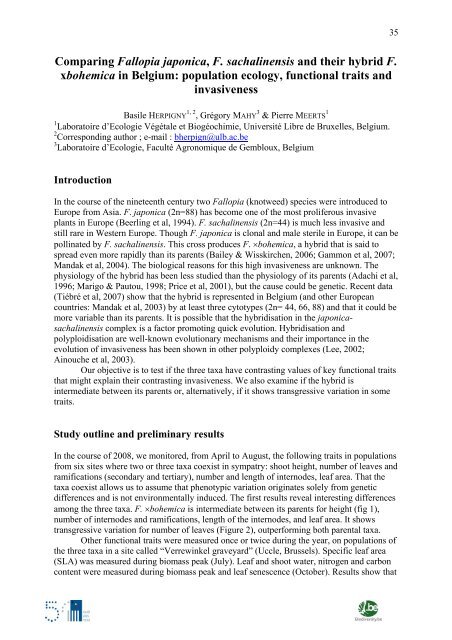Science Facing Aliens - Invasive Alien Species in Belgium - Belgian ...
Science Facing Aliens - Invasive Alien Species in Belgium - Belgian ...
Science Facing Aliens - Invasive Alien Species in Belgium - Belgian ...
Create successful ePaper yourself
Turn your PDF publications into a flip-book with our unique Google optimized e-Paper software.
Compar<strong>in</strong>g Fallopia japonica, F. sachal<strong>in</strong>ensis and their hybrid F.<br />
xbohemica <strong>in</strong> <strong>Belgium</strong>: population ecology, functional traits and<br />
<strong>in</strong>vasiveness<br />
Basile HERPIGNY 1, 2 , Grégory MAHY 3 & Pierre MEERTS 1<br />
1 Laboratoire d’Ecologie Végétale et Biogéochimie, Université Libre de Bruxelles, <strong>Belgium</strong>.<br />
2 Correspond<strong>in</strong>g author ; e-mail : bherpign@ulb.ac.be<br />
3 Laboratoire d’Ecologie, Faculté Agronomique de Gembloux, <strong>Belgium</strong><br />
Introduction<br />
In the course of the n<strong>in</strong>eteenth century two Fallopia (knotweed) species were <strong>in</strong>troduced to<br />
Europe from Asia. F. japonica (2n=88) has become one of the most proliferous <strong>in</strong>vasive<br />
plants <strong>in</strong> Europe (Beerl<strong>in</strong>g et al, 1994). F. sachal<strong>in</strong>ensis (2n=44) is much less <strong>in</strong>vasive and<br />
still rare <strong>in</strong> Western Europe. Though F. japonica is clonal and male sterile <strong>in</strong> Europe, it can be<br />
poll<strong>in</strong>ated by F. sachal<strong>in</strong>ensis. This cross produces F. ×bohemica, a hybrid that is said to<br />
spread even more rapidly than its parents (Bailey & Wisskirchen, 2006; Gammon et al, 2007;<br />
Mandak et al, 2004). The biological reasons for this high <strong>in</strong>vasiveness are unknown. The<br />
physiology of the hybrid has been less studied than the physiology of its parents (Adachi et al,<br />
1996; Marigo & Pautou, 1998; Price et al, 2001), but the cause could be genetic. Recent data<br />
(Tiébré et al, 2007) show that the hybrid is represented <strong>in</strong> <strong>Belgium</strong> (and other European<br />
countries: Mandak et al, 2003) by at least three cytotypes (2n= 44, 66, 88) and that it could be<br />
more variable than its parents. It is possible that the hybridisation <strong>in</strong> the japonicasachal<strong>in</strong>ensis<br />
complex is a factor promot<strong>in</strong>g quick evolution. Hybridisation and<br />
polyploidisation are well-known evolutionary mechanisms and their importance <strong>in</strong> the<br />
evolution of <strong>in</strong>vasiveness has been shown <strong>in</strong> other polyploidy complexes (Lee, 2002;<br />
A<strong>in</strong>ouche et al, 2003).<br />
Our objective is to test if the three taxa have contrast<strong>in</strong>g values of key functional traits<br />
that might expla<strong>in</strong> their contrast<strong>in</strong>g <strong>in</strong>vasiveness. We also exam<strong>in</strong>e if the hybrid is<br />
<strong>in</strong>termediate between its parents or, alternatively, if it shows transgressive variation <strong>in</strong> some<br />
traits.<br />
Study outl<strong>in</strong>e and prelim<strong>in</strong>ary results<br />
In the course of 2008, we monitored, from April to August, the follow<strong>in</strong>g traits <strong>in</strong> populations<br />
from six sites where two or three taxa coexist <strong>in</strong> sympatry: shoot height, number of leaves and<br />
ramifications (secondary and tertiary), number and length of <strong>in</strong>ternodes, leaf area. That the<br />
taxa coexist allows us to assume that phenotypic variation orig<strong>in</strong>ates solely from genetic<br />
differences and is not environmentally <strong>in</strong>duced. The first results reveal <strong>in</strong>terest<strong>in</strong>g differences<br />
among the three taxa. F. ×bohemica is <strong>in</strong>termediate between its parents for height (fig 1),<br />
number of <strong>in</strong>ternodes and ramifications, length of the <strong>in</strong>ternodes, and leaf area. It shows<br />
transgressive variation for number of leaves (Figure 2), outperform<strong>in</strong>g both parental taxa.<br />
Other functional traits were measured once or twice dur<strong>in</strong>g the year, on populations of<br />
the three taxa <strong>in</strong> a site called “Verrew<strong>in</strong>kel graveyard” (Uccle, Brussels). Specific leaf area<br />
(SLA) was measured dur<strong>in</strong>g biomass peak (July). Leaf and shoot water, nitrogen and carbon<br />
content were measured dur<strong>in</strong>g biomass peak and leaf senescence (October). Results show that<br />
35


